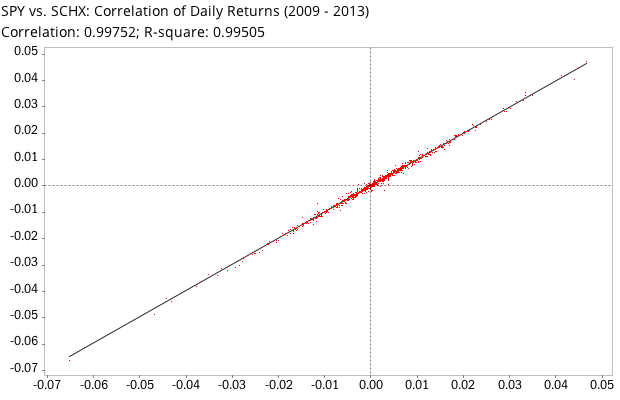LargeCap US Equity ETFs
Post on: 13 Июль, 2015 No Comment

Primary Data
SORT BY Date | Value Driver Showing results 81-100 out of 345
Oct 14, 2014 IYR XLE XLP XLV XLY
The U.S. Bureau of Economic Analysis issues PCE data, and the price index is a measure of the average increase in prices for all domestic personal consumption.
Oct 14, 2014 IVV IWM SPY TLT VXX
For example, at least historically, small cap valuations have been more sensitive to changes in monetary conditions than their large-cap counterparts, and this was evident last week.
Oct 10, 2014 GLD IVV SPY XLE XOP
While there’s not one substitute for TIPS, there are other asset classes that do a good job of hedging against inflation that investors may want to consider.
Oct 10, 2014 GLD IAU IVV SLV SPY
Gold certainly can be an inflation hedge, and it has worked in the past. Obviously, one of the reasons gold has been weak of late is that people are becoming less concerned about inflation.
Oct 10, 2014 EEM GLD IVV JNK SPY
But gold also does two other things, which make it worth having in the portfolio in small amounts. It’s diversifying as it behaves differently than paper assets
Oct 6, 2014 XLK XLF SPY IVV VXX
Before the technology (XLK) bubble burst of 2000, 62% of investors considered themselves bullish. 53% considered themselves bullish before the U.S. financial crisis (XLF) of 2008.
Oct 6, 2014 TLT SPY QWLD IVV EWJ
U.S. Treasury yields have been low this year due to the rise in geopolitical tensions. The slowdown in the Eurozone (or EZU) and Japan (EWJ) caused jitters in the markets.
Oct 6, 2014 TLT SPY IVV IEF BND
Most professional advice is focused on strategic asset allocation. It advises exposure to U.S. equities (SPY) and bonds (BND). The allocations are based on the investors financial goals and risk appetite.
Oct 6, 2014 SPY XLK XLF IVV QQQ
The investor holding of stocks hasnt decreased drastically—despite the stock market crashes during the technology bubble burst (XLK) of 2000 and the U.S. financial crisis (XLF) of 2008.
Oct 6, 2014 SPY XLF TLT BND IVV
On an average, 46% of the portfolios for non-Millennials were comprised of U.S. equities (SPY) (IVV). 15% of the portfolio was made up of U.S. bonds (BND) and Treasuries (TLT).
Oct 6, 2014 SPY TLT IYR IVV GLD
The recession after the financial crisis of 2007–2008 made investors wary of investing in U.S. markets. The S&P 500 (SPY) fell almost 57%—from 1,576 in October 2007 to 676 in March 2009.
Oct 6, 2014 XLK XLF SPY IYR IVV
During the U.S. financial (XLF) crisis, investors lacked confidence. They avoided stocks and increased their weight in cash. As the U.S. economy recovered, cash holdings decreased.
Oct 6, 2014 SPY XLU XLK DIA IWM
Currently, the S&P 500 is giving year-to-date (or YTD) returns of more than 8%. It posted gains for seven consecutive quarters. The S&P 500 Index (SPY) closed at a new high 34 times in 2014.
Sep 30, 2014 EEM EWJ FXI IVV SPY
One of the interesting aspects of last week’s sell-off was that two of Asia’s largest markets- China and Japan – managed to buck the downward trend and finish higher.
Sep 30, 2014 DIA IVV IWM QQQ SPY
While Russ doesn’t believe that last week’s sell-off reflects a fundamental shift in market conditions, he writes that it does provide two important lessons for investors.
Sep 30, 2014 EEM IEF IVV SPY TLT
If you’re looking to put your cash to work, you don’t have to spend hours developing a perfect strategy. Instead, I suggest two potential paths.
Sep 30, 2014 BND IEF IVV SPY TLT
Sitting in cash is not a strategy. While keeping some cash in your portfolio can be a good thing, it’s all too easy to make the mistake of keeping too much cash for too long.
Sep 30, 2014 EPI EWJ EWZ FXI SPY
In the interest of full disclosure, I must admit my own self-knowledge can be summed up by the adage, “the cobbler’s children have no shoes”. It’s true.
Sep 30, 2014 DIA IVV QQQ SPY VXX
The return expectations we have for our investments aren’t what they used to be. Continued market ups and downs have pushed many of us out of the market and into cash.














